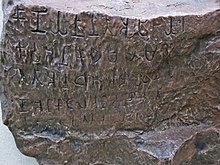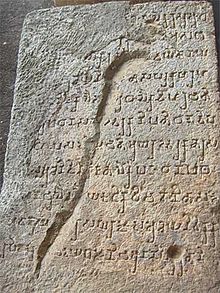






The earliest undisputed deciphered epigraphy found in the Indian subcontinent are the Edicts of Ashoka of the 3rd century BCE, in the Brahmi script.
If epigraphy of proto-writing is included, undeciphered markings with symbol systems that may or may not contain linguistic information, there is substantially older epigraphy in the Indus script, which dates back to the mid 4th millennium BCE. Two other important archeological classes of symbols are found from the 1st millennium BCE, Megalithic graffiti symbols and symbols on punch-marked coins, though most scholars do not consider these to constitute fully linguistic scripts, and their semiotic functions are not well understood.
Writing in Sanskrit (Epigraphical Hybrid Sanskrit, EHS) appears in the 1st to 4th centuries CE.[4] Indian epigraphy becomes more widespread over the 1st millennium, engraved on the faces of cliffs, on pillars, on tablets of stone, drawn in caves and on rocks, some gouged into the bedrock. Later they were also inscribed on palm leaves, coins, Indian copper plate inscriptions, and on temple walls.
Many of the inscriptions are couched in extravagant language, but when the information gained from inscriptions can be corroborated with information from other sources such as still existing monuments or ruins, inscriptions provide insight into India's dynastic history that otherwise lacks contemporary historical records.[5]
Of the c. 100,000 inscriptions found by the Archaeological Survey of India, about 60,000 were in Tamil Nadu;.[6] Over 25,000 Kannada inscriptions were unearthed in Karnataka, though an in depth study of many of these is yet to be conducted according to Hampi Kannada University Sociology department Head and Researcher Devara Kondareddy.[7] Over 14,000 inscriptions belonging to the Telugu language were excavated in Andhra Pradesh and Telangana. This makes Tamil and the two South Indian languages( Kannada and Telugu) the most densely inscribed languages in the country.
- ^ Hock, Hans Henrich; Bashir, Elena, eds. (24 May 2016). The Languages and Linguistics of South Asia: A Comprehensive Guide. Walter de Gruyter GmbH & Co KG. ISBN 978-3-11-042330-3.
- ^ John D. Bengtson (2008). In Hot Pursuit of Language in Prehistory: Essays in the Four Fields of Anthropology : in Honor of Harold Crane Fleming. John Benjamins Publishing. pp. 427–. ISBN 978-90-272-3252-6.
- ^ R. Umamaheshwari (2018). Reading History with the Tamil Jainas: A Study on Identity, Memory and Marginalisation. Springer. p. 43. ISBN 978-81-322-3756-3.
- ^ Salomon (1998), p. 81.
- ^ Keay, John (2000). India: A History. New York: Grove Press. pp. xx–xxi. ISBN 0-8021-3797-0.
- ^ Staff Reporter (22 November 2005). "Students get glimpse of heritage". The Hindu. Chennai, India. Archived from the original on 18 May 2006. Retrieved 26 April 2007.
- ^ "Take up study on unearthed inscriptions". 6 July 2011.
